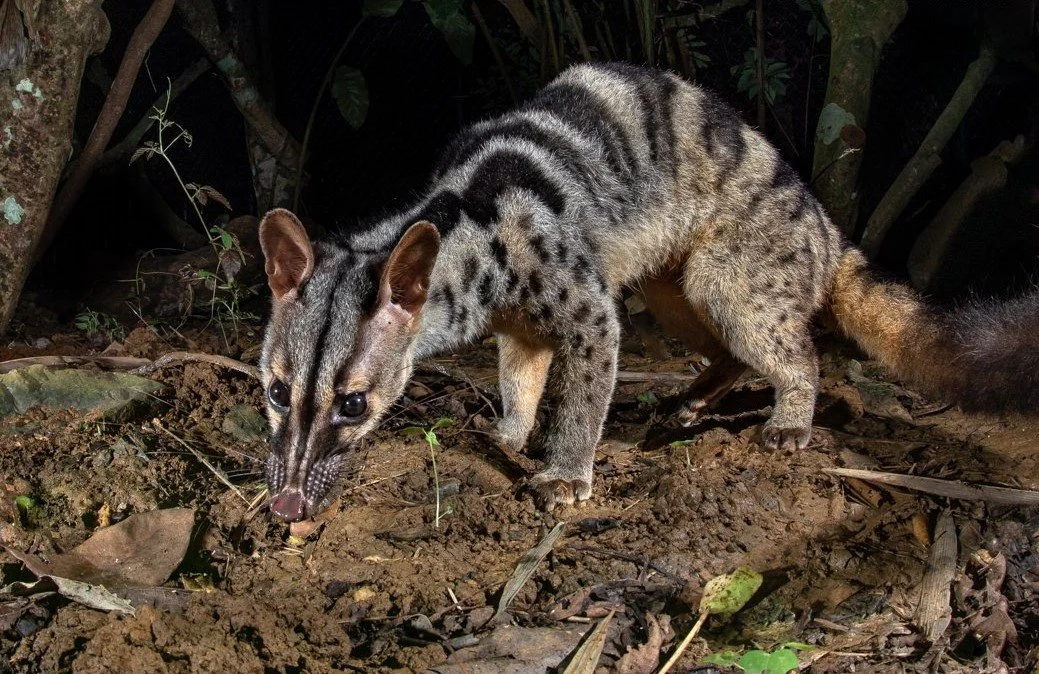Species
A collection of animal species from around the world.
*Sources for information and photos (unless they were taken by me) can be found at the bottom of each species profile.
Bawean Hog Deer
The Bawean hog deer is the rarest deer in the world. It's only found on the small Indonesian island of Bawean and is considered 'critically endangered' — with an estimated population of fewer than 300 individuals.
Owston's Civet
Owston's civet is a cryptic creature from the Annamite Mountains, straddling the border of Vietnam and Laos. With its skinny snout, it sniffs and searches through leaf litter for its favourite food: earthworms.
Iriomote Cat
The Iriomote cat occupies the smallest habitat of any wild cat on Earth — found only on Japan's southern Island of Iriomote — with its current population estimated to be around 100 individuals.
Blakiston's Fish-Owl
Blakiston's fish-owl is one of, if not the largest owl species in the world, with a wingspan reaching 2 metres (6.6 ft) and a weight exceeding 4 kilograms (8.8 lb). It is endangered — it's estimated that less than 2,000 individuals hunt the cold rivers of northeast Asia.
Japanese Pygmy Squid
The Japanese pygmy squid — one of the world’s smallest cephalopods with a mantle length of just 16 mm (0.6 in) — hunts crustaceans up to twice its size. It paralyses them, then slips its mouthparts inside their exoskeletons to slurp out their insides, leaving their shells intact.
Pheasant-tailed Jacana
Pheasant-tailed jacana females are larger than the males. The species is also polyandrous — each female mates with multiple males and, in a single season, lays up to 10 clutches that are raised by different males in her harem.
Bull-headed Shrike
The bull-headed shrike's shrieking call ('kich-kich-kich') signals the approach of fall in Japan — in some regions, farmers use its call to time their work and avoid the winter frosts. The shrike's cries also serve as warnings, staking its claim over hunting grounds.
Samurai Crab
The samurai crab's shell resembles the face of a samurai warrior. A popular theory proposed that fishermen spared the crabs with the most face-like shells, throwing them back instead — selectively breeding the species to resemble a scowling samurai. While a neat idea, it's unlikely to be true.
Brahminy Blind Snake
The Brahminy blind snake is also known as the 'flowerpot snake' because it often hides in the soil of flowerpots, resulting in its spread throughout most of the world. It looks and acts like a worm — some 13 cm (5 in) long and subterranean — but it's one of the world's smallest snake species.
Ground Tit
A resident of the Tibetan Plateau, the ground tit lives above the treeline at elevations no lower than 3,000 metres (9,800 ft). It moves along the ground in unpredictable dashes and hops — said to resemble a bouncing rubber ball — and digs burrows for nesting and shelter.
Okinawa Rail
The Okinawa rail is Japan's only flightless bird — found exclusively on the island of Okinawa. Before nightfall, it uses its powerful clawed feet to climb trees, where it sleeps to avoid nocturnal-hunting pit vipers. In the morning, it drops back down in a graceless fluttering of wings.
Nomura's Jellyfish
Nomura's jellyfish is among the largest jellyfish species in the world — measuring up to 2 metres (6.6 ft) in diameter and weighing up to 200 kg (440 lb). Starting out as small as a grain of rice, it can grow this large in less than a year.
Asian Openbill
The Asian openbill uses its "open bill" to locate and grab its favourite prey — freshwater snails — using the sharp tip of its curved, lower mandible to extract them from their shells. It is a common species of stork throughout South and Southeast Asia.
Long-eared Hedgehog
The ears of the long-eared hedgehog — longer than half the length of its head — are much larger than those of other hedgehogs. It lives in deserts and steps, using its astute hearing (and smell) to track down food, and its ample ears to radiate heat, staying cool in its sweltering home.
Coppersmith Barbet
The coppersmith barbet — a small bird about 16 cm (~6 in) long — often falls victim to bullying by other birds. Blue-throated barbets have been observed evicting coppersmiths from nesting holes, while red-vented bulbuls steal berries from male coppersmiths that are trying to feed their mates.
Black Drongo
The black drongo keeps its neighbourhood clear of predators by fearlessly assailing them — as a result, other birds like orioles, doves, babblers, and bulbuls like to nest near the drongo. But the drongo is also a trickster, mimicking the calls of raptors to scare birds into abandoning their food.
Anderson's Crocodile Newt
The ribs of Anderson's crocodile newt are untethered to any muscular attachments at their ends and jut into the skin along its back, giving it an armoured appearance. When threatened, it adopts an anti-predator posture — using its sharp rib tips to pierce the rows of bumps on its sides.
Steller's Sea-Eagle
Steller's sea-eagle is a rare raptor from the rocky coasts and rivers of northeastern Siberia — flying southwards to Hokkaido, Japan, in winter. It's the world's heaviest eagle and a particularly aggressive species, known to frequently steal fish caught by other eagles.
Lidth’s Jay
Lidth's jay is only found on a few of the Ryukyu Islands in southwestern Japan. Its existence has been threatened by the introduction of mongooses and an increased crow presence on these islands. As of a 2016 survey, fewer than 3,900 mature jays are estimated to remain.





















